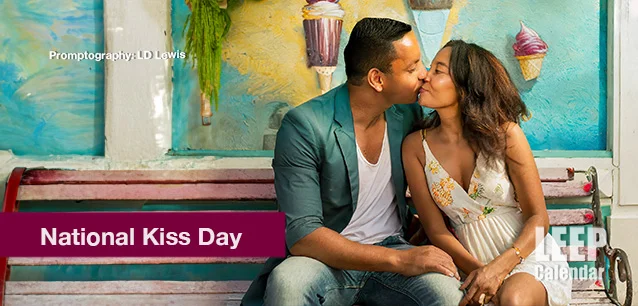 AD
AD
Today is: December 23
Scroll to explore events active on this date.
Additional Events on LEEP
LEEP INK FEATURES

2025 is the Year of...
21 Themes and 'Year of' Events for 2025 PART ONE, THE FIRST 12 Every year, various organizations announce the theme for the year. These themes can focus on causes, such as aesthetics and color tre...

Nuanced November 2024
November is the start of the holiday season in many parts of the world. It is a time for family, football, food, shopping and decorating, particularly in the Christian and Jewish world, leading to Christmas and...

December's Gift
Events in December 2024. Well, we made it to December. December is the holiday season, particularly in Western nations, where Christianity and Judaism are the faiths most common in the nation's past. ...
About Kiss Day
United States
Ends: Feb 13, 2025
DESCRIPTION:
The day before Valentine's Day is the unofficial holiday of National Kiss Day.
Kissing, a universal act of intimacy and affection has a multifaceted significance and history. It serves biological and social purposes as a powerful tool for human connection.
Biologically, kissing is thought to have evolved from premastication, where a mother chews food and feeds it mouth-to-mouth to her infant. This nurturing gesture likely evolved into a display of affection. On a more instinctual level, kissing enables potential mates to smell and taste each other, exchanging pheromones and other biological information crucial for mate selection. The kissing also releases dopamine, endorphins, and oxytocin, which promote euphoria, pleasure, and bonding.
Socially, the significance of kissing varies widely across cultures. It can represent a greeting, a sign of respect, a symbol of love, or a gesture of intimacy. The way people kiss also varies, reflecting different cultural norms and personal preferences.
There are numerous types of kisses, each carrying its meaning and context. Some of the most common kinds of kisses include:
The Peck—A quick, light kiss often used as a friendly greeting.
The French Kiss—A passionate kiss with intertwining tongues. It's a symbol of romantic and sexual desire.
The Inuit or Nose Kiss—Involves rubbing noses together and is common in some Inuit cultures.
The Forehead Kiss—a gesture of care and often signifies a deep emotional connection.
The Air Kiss—A social gesture where people kiss the air near the cheek, common in many European cultures.
The Hand Kiss—A sign of respect or chivalry. It involves lightly lifting and kissing the back of someone else's hand.
The history of kissing is equally diverse. The earliest literary evidence of kissing dates back to around 1500 B.C. in the Vedic Sanskrit texts from India. In ancient Rome, kisses were used as a legal bond to seal contracts. The Romans also categorized kisses into several types, such as romantic kisses (basium), passionate kisses (osculum), and spiritual kisses (suavium).
Over time, kissing evolved and spread globally, influenced by cultural exchanges and societal changes. In the Middle Ages, the Catholic Church attempted to regulate the practice, associating it with sin or immorality. However, kissing regained its romantic connotations with the Renaissance and the emphasis on human expression and art.
Today, kissing remains a powerful expression of various human emotions and intentions, deeply embedded in social rituals and personal relationships. Whether as a simple greeting or an intimate connection, kissing continues to evolve, reflecting the complex nature of human interaction and emotion.
VIDEOS
SUPPORTING DOCUMENTS
Currently, this event does not have supporting documents.
ADDITIONAL IMAGES
Currently, this event does not have supporting images.
Where would you like to go now?
 AD
AD


/footer-logo.svg)
